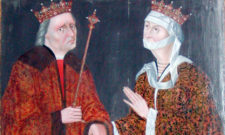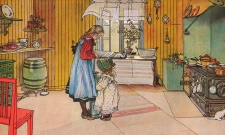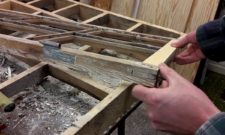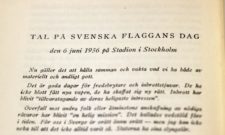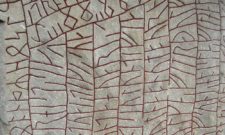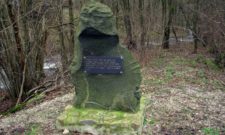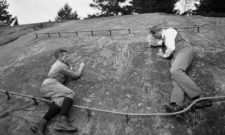Shop our historical maps
Culture
Advice for young hikers from 1888

May
Spring is here! Time to put your snowshoes and skis on the shelf and dust off your hiking boots. Here's some old hiking advice for youth from 1888.
A naturfolk. This is what Vilhelm Moberg called the Swedes in his book My Swedish history. Given the prominent position of outdoor recreation in today's Sweden, this term is just as relevant. At the risk of exaggerating (and possibly generalising from myself), it is true that many of us Swedes almost appreciate the company of nature more than we appreciate the company of other people.
It is to nature that I turn when I want to feel peace. It is to nature that I go when I want to breathe out. It is in nature that I feel at home. I just need to take a step into the woods and I feel like a playful child again.

Every year, thousands of us head out into nature on the many hiking trails and ancient paths that run through the many beautiful forests of the countryside. Trails and paths that generation after generation of our ancestors have walked on. One example is the 564 km long pilgrimage route S:t Olofsleden extending from Selånger in Medelpad to Nidarosdomen Trondheim in Trøndelag, Norway - from coast to coast.
The trail originates from a legend that says Olof the Holy landed in Selångers parish in early July 1030 after a few years in exile, and marched with his army to Norway to Christianize the country and take back the royal throne. In addition to the more well-known hiking trails, countless small forest paths, pastoral trails and picturesque old village roads remain, waiting patiently for the sound of the wanderer's cheerful steps.
To help the young, aspiring hiker, I have dug out a few hiking tips from The Swedish Tourist Association's annual journal from the year 1888. The advice is written down by Fredrik Svenonius (1852-1928) in Uppsala, a Swedish geologist who was also involved in the formation of Swedish Tourist Association 1885. Among other things, he was editor of the STF's annual journal during its first five years of publication (1886-1890).
Why then should youth tear themselves away from their screens and go out and wander? If you ask Svenonius, it is "not only the sense of country that is kindled, when in forest and lake, on mountain and fairy, one gets to know old Sweden and its people, but thereby one also strengthens one's soul and body, one learns to be resourceful and courageous and to help oneself, and one should at least learn to be simple and moderate in his habits of life, and to esteem all honest work. For these and many other reasons, which need not be repeated here, it is highly desirable that the growing generation should be accustomed to go out on walking tours during the school holidays."
Here is some advice from Svenonius on what to consider when setting off on adventures in our vast country:
Hoof Head Rules
A) Clothing. practical, but as simple and slightly "sporty" as possible. Clothes should be well equipped with deep and secure pockets.
B) Cash. Spend as little money as possible and never extravagate on cellars and guesthouses! Don't forget to keep careful cash (and day) records. (10 - 15 crowns a week should usually be enough.)
C) Disposal method. Use the "apostle horses" as much as possible. A good footpath is less tiring than a smooth country road When rowing, always take part yourself! Never travel by rail except in 3rd class.
D) Way of life. Come along and get to know the people! Don't go just for the sake of going! Don't see the common man "through the snob's pincenez"!
E) Quarter. Do not think impossible to get quarters (and food) even if guesthouses are missing! A decent and modest person is almost never turned away. Often the misgivings sometimes expressed are not so serious. - To lie out on a hot summer's night in case of need does no harm at all.
Fredrik Svenonius (1852-1928)

Equipment
1) Skodonen: low (or no) heels. All, both natives and settled southern Swedes, who have had the opportunity to use ski boots ("band shoes") for any length of time in the mountains and wildernesses of Norrland, unanimously confirm that one does not harden so well in any footwear as in these (even on stony ground, when one has acquired some habit). But they must not be used in regions where the population does not understand their care [If a healthy boy ever wants to try in the summer heat whether "the foot will stand up without a shoe" now, as in the old, simple and strong times, he will not be the worse for it!
2) Pants: not tight around the legs; if the knee is not felt freely, one soon tires. If the trousers are not laced into the shoe-shaft, it is advantageous, when walking on hilly ground, to tie them up slightly with a lightly attached strap below the knee.
3) Raincoat: not too long; either a regular "guling" or a gutta-percha cape.
4) Hoof headgear: not susceptible to rain.
5) Theänseln: At its lower edge, which soon tends to make the back sore, though it appears good when probed, may be fastened a small bag in the shape of a dune, into which hay, moss, or dirty linen and socks are put. If the cleaner is equipped with a so-called knife (practical!), the pad is placed at the lower end of the knife, but is then needed less. Northern and Finnish nosepieces are very practical as runners.
Bring as little as possible, e.g.: a pair of Jäger shirts, a coloured shirt, a few pairs of socks, some handkerchiefs and collars, a spare pair of trousers; comb, clothes brush, soap and towel; needle, thread and buttons; linen patches, cerate and a small box of boric acid or boric acid plasters (for foot ulcers); if the walk is in very mosquito-infested areas, a couple of cubic inches of beech oil (pharmacy product) should be taken; finally, the maps needed (topographical corps map sheets, where they are ready) and some postcards. Compass (as simple as possible), note-book, etc., are carried in the pocket.[3]
Don't forget the proverb: "long way makes small burden heavy!" (10 kilograms on your back will be noticeable enough for a youngster in the long run.)

Svenonius concludes with a wise piece of advice that has survived to this day:
Finally another main rule, the most important: a firm resolve not to be "fussy" or fussy about little things, and to make constant efforts to a good and cheerful mood!
Subscribe to YouTube:
If you appreciate Allmogens independent work to portray our fine Swedish history and Nordic culture, you are welcome to buy something nice in the shop or support us with a voluntary donation. Thank you in advance!
Support Allmogens via Swish: 123 258 97 29
Support Allmogens by becoming a member
Support Allmogens in your will
